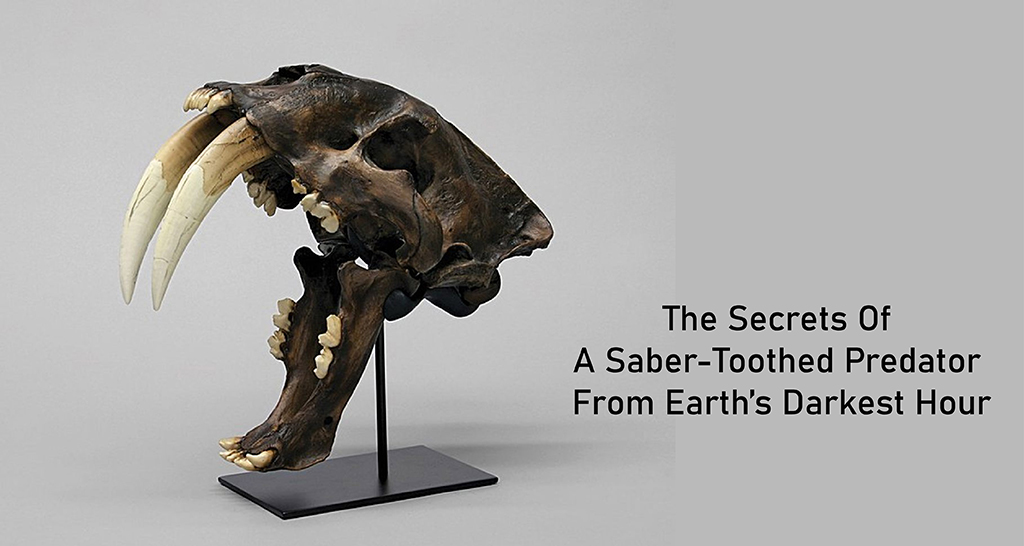The fossils of an amazing saber-toothed predator provide insights into a difficult time called “the Great Dying.” It Happened 250 million years ago, it was caused by big volcanoes erupting in Eurasia. The extreme climate change that followed made nearly 90% of life on Earth disappear, making way for dinosaurs later on. Recent findings in South Africa’s Karoo Basin showed that the saber-toothed mammal ancestor Inostrancevia lived there too, even though we thought it only lived in the Northern Hemisphere. This discovery tells us how ancient animals coped with hard times and changed to survive.
A Predator’s Journey:
Amazing fossils of Inostrancevia were found in South Africa, far from its known home in Russia. The fossils, such as skulls, ribs, vertebrae, and leg bones, took many years to carefully prepare and surprised researchers with their unexpected characteristics. Inostrancevia, a creature similar in size to a tiger, had skin resembling that of a rhino or an elephant. It managed to migrate about 7,000 miles across the supercontinent Pangaea to survive and become a predator in a different environment. This shows how resilient and adaptable ancient species could be, even when faced with significant challenges.
Nature Abhors a Vacuum:
The Permian mass extinction, known as “the Great Dying,” took place over one million years. Fossils show that Inostrancevia became a key predator in the Southern Hemisphere after other large predators went extinct. The quick change of top predator roles, within a couple of million years, highlights the unstable state of ecosystems during that time. This is very different from the relatively stable roles of top predators we see today.
The Mirror of Extinction:
Studying the Permian mass extinction helps us understand the current climate crisis and biodiversity loss. As another mass extinction looms, it’s crucial to grasp the impacts and consequences. Researchers stress the lack of modern comparisons to truly comprehend the seriousness of the current crisis. The Permian-Triassic extinction serves as a reminder of the potential consequences of climate change and biodiversity loss, urging us to address these urgent issues.
Lessons from the Past:
The Karoo Basin in South Africa is a treasure trove of information about life on land before and after the Permian mass extinction. With plenty of fossils and continuous rock exposures, scientists have pieced together detailed stories of ancient ecosystems. Further research, including exploring fossil sites in northern Africa, can help us learn even more about the lives and movements of ancient species.
Further Discoveries: Unveiling Inostrancevia’s Ecological Interactions
Continued research on the fossils of Inostrancevia has revealed fascinating insights into its ecological interactions and behavior during the Great Dying. Paleontologists have meticulously analyzed the anatomical features of Inostrancevia and its dental structures, shedding light on its predatory strategies and dietary preferences.
Inostrancevia had impressive saber-like teeth that it used to immobilize and quickly kill its prey. Scientists have studied the teeth and found that Inostrancevia likely aimed for important areas like the throat or abdomen. While its teeth were specialized for slicing and tearing flesh, recent research suggests that Inostrancevia had a varied diet. It didn’t just rely on large plant-eating animals but also ate smaller ones, scavenged dead animals, and possibly even targeted smaller predators or reptiles. This ability to eat different things helped it survive during the tough times of the Great Dying when there wasn’t much food and lots of competition.
Inostrancevia was a clever predator that used its power and quickness to catch its prey. It could move quickly and had sharp teeth for tearing apart its food. They might have lived in groups or defended territories, but there is a need for more evidence to determine if they lived in groups or defended territories. Inostrancevia survived by being adaptable and finding different types of food during the mass extinction. Studying ancient predators like Inostrancevia helps us understand how to protect animals today.
Finding Inostrancevia in South Africa makes scientists curious about its family and what it turned into. They want to learn more about the ancient predators and how they became famous animals like sabertooth cats. Scientists will explore different places in the world to find more evidence about Inostrancevia’s family and how they changed over time. This will help us understand more about these interesting animals and the history of life on Earth.
In conclusion, the discovery of Inostrancevia’s fossils has provided valuable insights into how ancient species adapted to challenging times, such as the Great Dying. Inostrancevia’s ability to migrate and adapt to new environments showcases its resilience. Through the study of Inostrancevia and its descendants, a deeper understanding emerges regarding their hunting techniques, social behavior, and diverse diet. These findings shed light on the unstable nature of ecosystems during that era and carry implications for the current climate crisis and the imperative to safeguard biodiversity. Exploring the history of life on Earth enables us to strive toward a more sustainable future.

